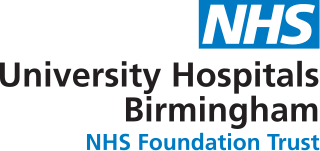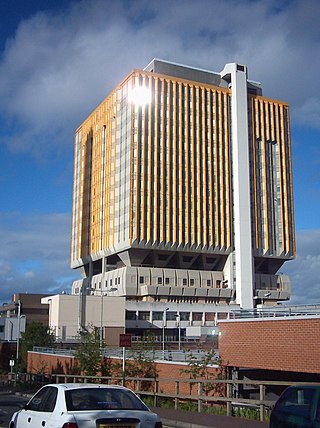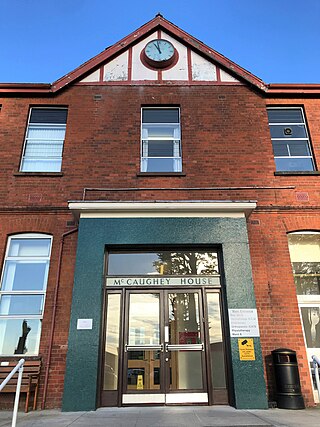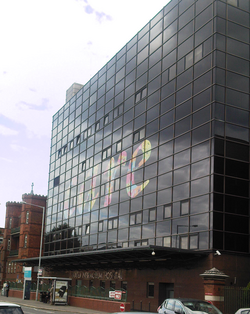
The Mater Misericordiae University Hospital, commonly known as the Mater ( "matter"), is a major teaching hospital, based at Eccles Street, Phibsborough, on the northside of Dublin, Ireland. It is managed by Ireland East Hospital Group.

The Countess of Chester Hospital is the main NHS hospital for the English city of Chester and the surrounding area. It currently has 625 beds, general medical departments and a 24-hour accident and emergency unit. It is managed by the Countess of Chester Hospital NHS Foundation Trust, one of the first Foundation Trusts in the UK, formed in 2004. Cardiac rehabilitation services at the hospital are provided by Cheshire and Wirral Partnership NHS Foundation Trust.

The Royal Victoria Hospital commonly known as "the Royal", the "RVH" or "the Royal Belfast", is a hospital in Belfast, Northern Ireland. It is managed by the Belfast Health and Social Care Trust. The hospital has a Regional Virus Centre, which is one of the four laboratories in the United Kingdom on the WHO list of laboratories able to perform PCR for rapid diagnosis of influenza A (H1N1) virus infection in humans.

The University Hospitals Birmingham NHS Foundation Trust provides adult district general hospital services for Birmingham as well as specialist treatments for the West Midlands.

Altnagelvin Area Hospital is the main hospital for the North West of Northern Ireland. It is located in Waterside, Derry. It provides services to the city of Derry and County Londonderry, but also some specialist and acute services for parts of neighbouring County Donegal, County Tyrone, County Antrim and County Fermanagh. It is managed by the Western Health and Social Care Trust.

St Richard's Hospital is a medium-sized District General Hospital (DGH) located in Chichester, West Sussex, England. It is now part of University Hospitals Sussex.

Ealing Hospital is a district general NHS hospital, part of London North West University Healthcare NHS Trust, located in the Southall district of the London Borough of Ealing, West London, England. It lies on the south side of the Uxbridge Road 8.5 miles west of central London. It sits between Southall town centre to the west and Hanwell to the east. It is built on land that was once part of St. Bernard's Hospital which is run by West London Mental Health (NHS) Trust. The Ealing Hospital Interchange bus station is adjacent to the hospital.

The Belfast City Hospital in Belfast, Northern Ireland, is a 900-bed modern university teaching hospital providing local acute services and key regional specialities. Its distinctive orange tower block dominates the Belfast skyline being the third tallest habitable storeyed building in Northern Ireland. It has a focus on the development of regional cancer and renal services. It is managed by Belfast Health and Social Care Trust and is the largest general hospital in the United Kingdom. In April 2020, due to the global coronavirus pandemic, the tower block was designated one of the UK's Nightingale Hospitals.

Furness General Hospital (FGH) is a hospital located in the Hawcoat area of Barrow-in-Furness, Cumbria, England. It is managed by the University Hospitals of Morecambe Bay NHS Foundation Trust.

Musgrave Park Hospital is a specialist hospital in Belfast, Northern Ireland. It specialises in orthopaedics, rheumatology, sports medicine and rehabilitation of patients of all ages. These specialties are spread out across a large site in the leafy suburbs of South Belfast. The Hospital is named after the 48 acres (19 ha) of adjacent municipal parkland known as Musgrave Park, first opened to the public in 1920. The hospital is managed by the Belfast Health and Social Care Trust.
The Belfast Health and Social Care Trust (BHSCT) is a health organisation covering Belfast, Northern Ireland. The trust is one of five new trusts which were created on 1 April 2007 by the then Department of Health, Social Services and Public Safety (DHSSPS). The Belfast Trust employs 22,000 staff. It has responsibility for services to over 340,000 patients, provided at various hospitals including Belfast City Hospital, the Royal Victoria Hospital, the Mater Hospital and Musgrave Park Hospital.

The Ulster Hospital, commonly known as the Ulster, is a teaching hospital in Dundonald in County Down, Northern Ireland. It is within the townland of Ballyregan, beside the A20 road. It provides acute services in the North Down, Ards and Castlereagh council areas, as well as east Belfast. It is managed by the South Eastern Health and Social Care Trust.

The Royal Belfast Hospital for Sick Children is a specialised government children's hospital and medical centre in Belfast, Northern Ireland. It is managed by the Belfast Health and Social Care Trust and is the only hospital in Northern Ireland dedicated to children.

South West Acute Hospital is a local teaching hospital located in Enniskillen, County Fermanagh, Northern Ireland. It is managed by Western Health and Social Care Trust.

Forster Green Hospital was a non-acute hospital located in Belfast, Northern Ireland. It offered a range of services including neurology, care of older people, and a child and family centre. The hospital was located on a 47-acre site in South Belfast. It was managed by the Belfast Health and Social Care Trust and closed in 2012. Located within the hospital grounds is the regional child and adolescent mental health inpatients unit, Beechcroft. This opened in 2010. Knockbreda Wellbeing and Treatment centre is also located within the grounds of Forster Green and opened in 2009. This has been described as a "one stop approach" to healthcare as it offers a wide range of healthcare services for the local community including general practice and physiotherapy.

Whiteabbey Hospital is a hospital located close to the village of Whiteabbey, within the town of Newtownabbey, Northern Ireland. The hospital first opened in 1907 as The Abbey Sanitorium, centred around a country house known as 'The Abbey'. The house has stood on the site from 1850, and was once the residence of prominent architect Charles Lanyon. The hospital was extended and several buildings added throughout the early 20th century, and it was renamed Whiteabbey Hospital in 1947. The hospital is managed by the Northern Health and Social Care Trust. Many healthcare services have been withdrawn from the hospital, most recently with the closure of the Minor Injuries Unit in 2014.

Holywell Hospital is a facility that provides a range of mental health services in the Northern Health and Social Care Trust. Based on a 140-acre site in Antrim, the 149-bed facility is managed by the Northern Health and Social Care Trust.

The Royal Jubilee Maternity Hospital is a maternity facility in Grosvenor Road, Belfast, Northern Ireland. It is managed by the Belfast Health and Social Care Trust.
COVID-19 hospitalsin the United Kingdom are temporary hospitals set up in the United Kingdom and overseas territories as part of the response to the COVID-19 pandemic.
Professor Sir Michael Oliver McBride is a consultant physician who has served as the Chief Medical Officer for Northern Ireland since September 2006.


















